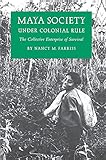Maya Society under Colonial Rule : The Collective Enterprise of Survival / Nancy Marguerite Farriss.
Material type: TextPublisher: Princeton, NJ : Princeton University Press, [2021]Copyright date: ©1984Description: 1 online resource (600 p.)Content type:
TextPublisher: Princeton, NJ : Princeton University Press, [2021]Copyright date: ©1984Description: 1 online resource (600 p.)Content type: - 9780691235400
- 972/.6500497 19
- F1435 .F28 1984
- online - DeGruyter
| Item type | Current library | Call number | URL | Status | Notes | Barcode | |
|---|---|---|---|---|---|---|---|
 eBook
eBook
|
Biblioteca "Angelicum" Pont. Univ. S.Tommaso d'Aquino Nuvola online | online - DeGruyter (Browse shelf(Opens below)) | Online access | Not for loan (Accesso limitato) | Accesso per gli utenti autorizzati / Access for authorized users | (dgr)9780691235400 |
Frontmatter -- CONTENTS -- ILLUSTRATIONS -- TABLES, FIGURES, AND MAPS -- PREFACE -- ACKNOWLEDGMENTS -- INTRODUCTION -- PROLOGUE -- PART ONE THE IMPLICATIONS OF CONQUEST -- 1 A COLONIAL REGIME -- 2 INDIAN REACTIONS AND SPANISH MODIFICATIONS -- 3 A DIVIDED COLONIAL WORLD -- PART TWO A FRAGILE SOCIAL ORDER -- 4 THE ELUSIVE SOCIAL BOND -- 5 CREATION OF THE COLONIAL COMMUNITY -- 6 SNAGS AND TEARS IN THE SOCIAL FABRIC -- 7 POPULATION MOVEMENTS: THE FRAYING EDGES -- PART THREE ADAPTATION AND SURVIVAL -- 8 MAYA ELITES: THE FIXED CENTER -- 9 SURVIVAL AS A CORPORATE ENTERPRISE -- 10 THE COSMIC ORDER IN CRISIS -- 11 MAINTAINING THE COSMOS -- PART FOUR NEO-COLONIAL SOCIETY -- 12 THE SECOND CONQUEST -- EPILOGUE -- APPENDIX 1 POPULATION OF YUCATAN, 1806 -- APPENDIX 2 SOURCES AND METHODS -- NOTES -- GLOSSARY -- BIBLIOGRAPHY -- INDEX
restricted access online access with authorization star
http://purl.org/coar/access_right/c_16ec
This book traces the history of the Maya Indians of Yucatan, Mexico,during a four-hundred-year period from late preconquest times throughthe end of Spanish rule in 1821. Nancy Farriss combines the tools of thehistorian and the anthropologist to reconstruct colonial Maya society andculture as a web of interlocking systems, from ecology and modes ofsubsistence through the corporate family and the community to the realmof the sacred. She shows how the Maya adapted to Spanish domination,changing in ways that embodied Maya principles as they applied theirtraditional collective strategies for survival to the new challenges; they fared better under colonial rule than the Aztecs or Incas, who lived in areas more economically attractive to the conquering Spaniards. The author draws on archives and private collections in Seville, Mexico City, and Yucatan; on linguistic evidence from native language documents; and on archaeological and ethnographic data from sources that include her own fieldwork. Her innovative book illuminates not only Maya history and culture but also the nature and functioning of premodern agrarian societies in general and their processes of sociocultural change, especially under colonial rule.
Mode of access: Internet via World Wide Web.
In English.
Description based on online resource; title from PDF title page (publisher's Web site, viewed 30. Aug 2021)


